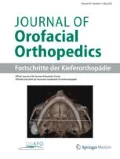Abstract.
Background: The relationship between maxillary canine displacement and the simultaneous occurrence of “genetically determined predisposition to disturbed development of the dentition” as defined by Hoffmeister [20] was investigated in 675 patients.
Patients and Methods: Panoramic radiographs taken of each patient during the first and the second mixed dentition periods were evaluated. Canine inclination and the distance between the tip of the canine and a line connecting the cusps of the molars were computed in five different age groups according to Dausch-Neumann [11].
Results: Statistical analysis revealed 34 patients with “potential canine displacement”, who exhibited further symptoms of “genetically determined predisposition to disturbed development of the dentition” significantly more frequently than the total group. The symptoms concerned were agenesia, displaced tooth buds, rotated or tilted incisors, aplasia and microdontia of lateral incisors.
Conclusion: Careful follow-ups in patients with a predisposition to disturbed dental development enables risks to be anticipated and canine displacement to be detected at an early stage.
Zusammenfassung.
Hintergrund: Die vorliegende Studie überprüft den Zusammenhang von Eckzahnverlagerung im Oberkiefer mit dem gleichzeitigen Vorkommen von genetisch determinierten “Störanfälligkeiten der Gebissentwicklung” wie Hoffmeister [20] sie definiert hat anhand von 675 Patienten.
Patienten und Methoden: Von jedem Patienten wurden Orthopantomogramme in der ersten und zweiten Wechselgebissperiode ausgewertet. In Anlehnung an Dausch-Neumann [11] wurden die Eckzahnneigung und zusätzlich der Abstand der Eckzahnspitze von einer konstruierten Molarenverbindungslinie in fünf Altersgruppen berechnet.
Ergebnisse: Statistisch wurden 34 Patienten mit “potentieller Eckzahnverlagerung” ermittelt. Gegenüber der Gesamtgruppe kamen bei ihnen signifikant häufiger weitere Symptome der “genetisch determinierten Störanfälligkeit” vor. Dies waren Nichtanlagen, falsche Keimlagen, Dreh- und Kippstände von Schneidezähnen, Aplasie und Formreduktion des seitlichen Schneidezahnes.
Schlussfolgerung: Bei sorgfältiger Beobachtung der Gebissentwicklung lassen Störanfälligkeiten eine risikobehaftete Gebissentwicklung vermuten und eine Früherkennung der regelrechten oder gestörten Einstellung des oberen Eckzahnes zu.
Similar content being viewed by others
Author information
Authors and Affiliations
Additional information
Received: April 15, 2002; accepted: January 30, 2003
Dedicated to Professor Dr. Ursula Klink-Heckmann on the occasion of her 75 th birthday.
Correspondence Address Dr. Franka Stahl, Poliklinik für Kieferorthopädie der Universität Rostock, Strempelstrasse 13, 18057 Rostock, Germany, Phone (+49/381) 494-6650, Fax -6652, e-mail: Franka.Stahl@medizin.uni-rostock.de
Rights and permissions
About this article
Cite this article
Stahl, F., Grabowski, R. Maxillary Canine Displacement and Genetically Determined Predisposition to Disturbed Development of the Dentition. J Orofac Orthop 64, 167–177 (2003). https://doi.org/10.1007/s00056-003-0221-y
Issue Date:
DOI: https://doi.org/10.1007/s00056-003-0221-y




